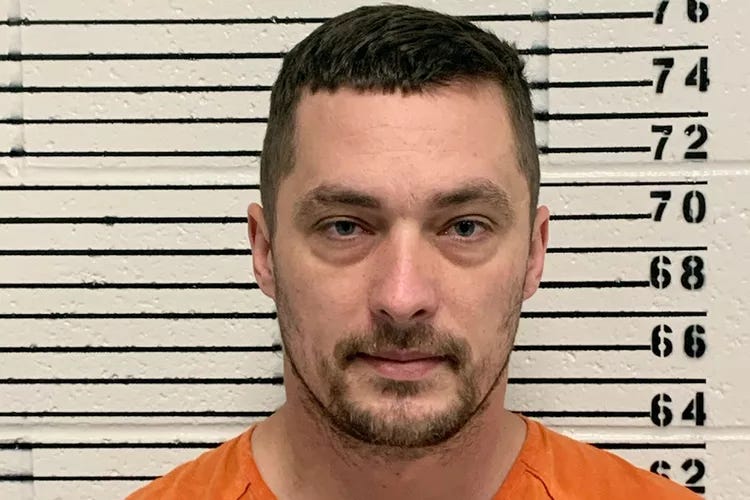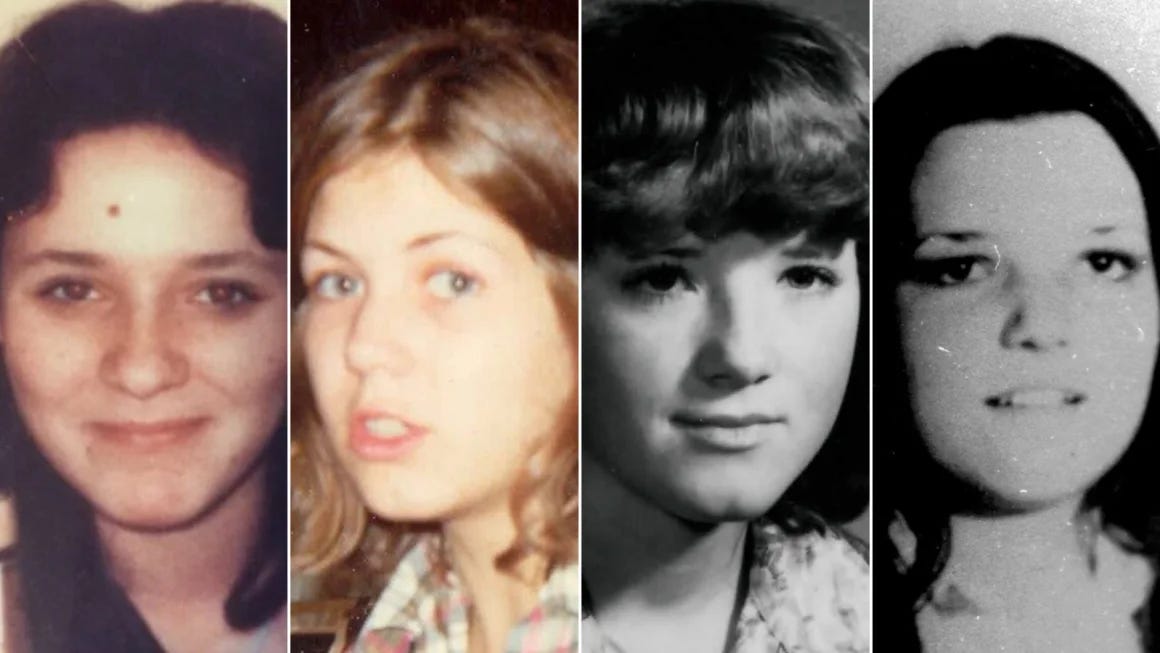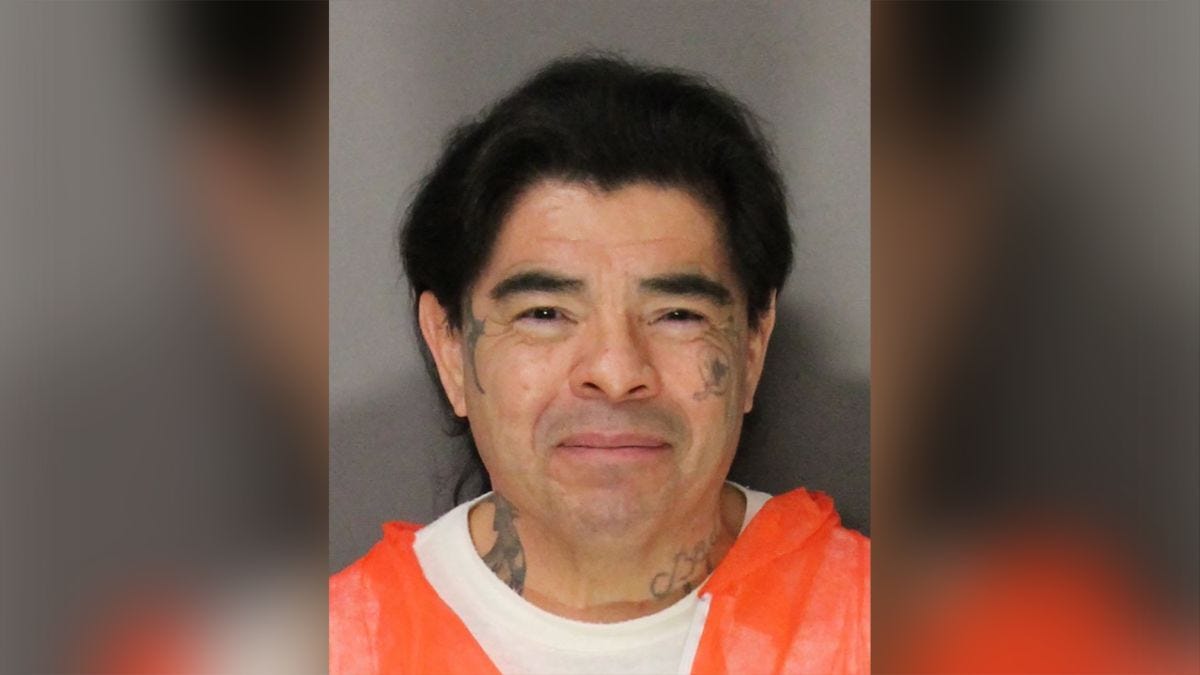It was Ted Bundy's rampage at Florida State University's sorority house - eighty miles away from where I was enjoying my senior year in high school - that sparked my interest in forensic psychology. I've spent my career evaluating violent offenders and researching serial killers. This past week, four accused or convicted serial killers have grabbed the headlines. We're going to take a look at each of them from a forensic psychology perspective - examining the factors that may have contributed to them becoming killers and exploring their motives and modus operandi.
First, we have Christopher Wilder. Hulu recently featured several of his survivors in a new documentary series, "The Beauty Queen Killer: 9 Days of Terror." Next, we turn to Jesse Lee Calhoun, a convicted sex offender who was recently indicted on multiple counts of murder and abuse of a corpse in connection with the deaths of three women in Portland. The third killer to have resurfaced in the news is Gary Allen Srery, a man whose DNA was recently linked to the brutal murders of four young women and girls in Alberta, Canada, in the 1970s. Finally, we come to Paul Allen Perez, a man accused of the unthinkable: the serial murder of five of his own infant children over nine years.
Christopher Wilder: The "Beauty Queen Killer"
Born in Australia and immigrating to the United States at age twenty-four, Christopher Wilder (March 13, 1945 - April 13, 1984) led a double life that masked his true nature as a ruthless predator. He appeared to be a successful businessman and race car driver to the outside world, earning a small fortune in the construction business. He was also known for his lavish lifestyle and magnetic personality. He leveraged his reputation and charm to gain the trust of young women, often promising them lucrative (nonexistent) modeling contracts or offering to do photo shoots.
However, this charismatic facade masked a deeply disturbed individual with a history of violence and sexual deviance. Wilder eventually earned the chilling monikers of the "Beauty Queen Killer" and the "Snapshot Killer" due to his targeting of young, aspiring models.
Wilder's background provides some insights into the factors that may have contributed to his development as a serial killer. Born to an American naval officer and an Australian mom, he was so sickly as a child a priest gave him the last rites. He almost drowned in a swimming pool at age two. At three, he began seizing in a family car and had to be resuscitated.
His childhood was reasonably stable, but he was peeping into his female neighbors' windows by early adolescence. At seventeen, he and some peers were arrested and convicted of gang rape. He managed to avoid prison but received mandated counseling and electroshock therapy. (Some records indicate that he not only exhibited more violence after receiving electroshock but began fantasizing about electrocuting girls while having sex with them).
Several therapists noted Wilder's need to dominate women and his desire to kidnap a woman and turn her into his sex slave. In 1969, his wife of eight days left him after suffering sexual abuse and discovering nude photos and unfamiliar panties in his briefcase. That same year, a nurse told police that Wilder had used nude pictures in an attempt to extort sex; even though the charges were eventually dropped because the victim didn't want to testify, Wilder decided it was time for a fresh start in the land of opportunity.
Wilder's criminal career in the U.S. began in March 1971 when he was arrested for soliciting women to pose for nude photos. He stayed off the police radar for six years, and then, in October 1977, he forced a teenager to perform oral sex after threatening to beat her if she didn't comply. He privately confessed to his therapist but was acquitted. By 1981, Wilder had progressed to kidnapping and rape, but by the time his sex crimes reached a terrifying crescendo in 1984 when he embarked on a two-month murder spree that left at least eight women dead across the country, he had not spent a single day behind bars.
During this time, he would often approach young women in shopping malls or other public places, using his charm and offers of modeling work to lure them into his car. Once he had them in his grasp, he would force them to pose for explicit photos before brutally assaulting and killing them.
One of the most disturbing aspects of Wilder's crime spree was his kidnapping of 16-year-old Tina Risico. Wilder abducted Risico and forced her to accompany him on a nine-day cross-country nightmare. Wilder subjected her to unimaginable physical, sexual, and psychological abuse. He used her as bait to lure other victims and coerced her into assisting with his crimes. Risico later described the terror and confusion she felt as Wilder alternated between acts of brutality and moments of apparent kindness. Fortunately, Wilder's reign of terror came to an end in a dramatic shootout with police in New Hampshire in 1984.
Tina Marie Risico
Forensic Observations:
Risico's harrowing ordeal and eventual escape provide a rare glimpse into the mind of a serial killer and the psychological manipulation he employed to maintain control over his victims. His use of terror and fear, interspersed with random and intermittent acts of mercy, is a deviant example of a variable ratio learning schedule, in which rewards are unpredictable, and is one of the most potent ways to shape human behavior.
Wilder's history of near-drowning (during which he would have been deprived of oxygen) and subsequent seizures raises the question of whether organic brain damage could have been a contributor to Wilder's deviant sexual behavior. (As an adult, he also complained of blackouts). Research suggests that one out of every four serial killers has a history of documented head trauma. Of course, this means that seventy-five percent do not and that head trauma, in and of itself, is not a cause of serial murder.
If this isn't a cautionary tale, I don't know what is. Wilder was peeping by early teens, gang-raping at seventeen, and extorting and threatening women in his early twenties. Therapy changed nothing; therapists repeatedly documented his deviant sexual fantasies and, on at least one occasion, his sex crimes. And yet, he was repeatedly released on bail and put on probation, ordered into more treatment instead of confinement. Wilder's case underscores the importance of seriously taking early warning signs of problematic behavior. Had his earlier crimes been dealt with more severely, or had those around him been more attuned to the red flags in his behavior, perhaps some of his later victims could have been spared.
Jesse Lee Calhoun: A Trail of Terror in Oregon
Thirty-nine-year-old Jesse Lee Calhoun has shaken the Portland, Oregon, community to its core. This week, a Multnomah County grand jury indicted him on multiple counts of second-degree murder and abuse of a corpse. The charges stem from the deaths of three women - 24-year-old Charity Lynn Perry, 31-year-old Bridget Leann Webster, and 32-year-old Joanna Speaks - whose bodies were found in wooded areas around Portland, Oregon, between February and May 2023.
Rumors of a serial killer in the Pacific Northwest began to surface after the bodies of six women were discovered last year. Law enforcement publicly discounted the rumors while working to investigate whether or not there was a connection. As the investigation progressed, Jesse Calhoun became a common denominator, at least with four of the women.
An ex-girlfriend of the accused, Krista Sinor, said that twenty-two-year-old Ashley Real had been in a sexual relationship with Calhoun between December 2021 and at least December 2022; she was last seen at a fast food restaurant on March 27, 2023, in Portland. In a disturbing revelation, one of the victims, Ashley Real, had told Portland police that Calhoun had attacked and strangled her in November 2022, just months after his release. However, this alleged attack was never referred to the district attorney's office for prosecution, and Calhoun has not been charged in connection with Real's death.
Sinor also told the interviewer that Calhoun had a sexual relationship with another victim. She claims she had seen a topless video of one of the other victims, Bridget Leann, 31, on Calhoun's phone. According to Sinor, when she first saw the video, she did not know who the woman was, but after seeing Leann's picture in the news, she recognized her as the girl in Calhoun's video. She also claims she found messages between the two that suggest that Calhoun would give Leann fentanyl in exchange for sex.
Calhoun's criminal history paints a picture of a man with a troubled past and a propensity for violence. He served the second half of a four-year sentence at the Snake River Correctional Institute in Ontario for a burglary and car theft case dating back to 2019. However, in 2021, then-Gov. Kate Brown commuted Calhoun's sentence and 40 other prisoners to reward their service as volunteer firefighters. The commutation of Calhoun's sentence has come under scrutiny in light of his alleged involvement in the murders of three women in Portland, Oregon, in 2023.
Forensic Observations:
These details paint a chilling picture of a man who may have quickly resumed his violent and predatory behavior after being granted early release from prison. The apparent lack of effective monitoring and the failure to take action on the reported attack on Real raise serious questions about the system's ability to protect the public from individuals with a demonstrated history of violence and sexual offenses.
From a forensic psychology perspective, the case of Jesse Lee Calhoun highlights the critical importance of comprehensive risk assessment and robust post-release supervision for offenders with a history of serious crimes. While the concept of redemption and second chances is an essential principle of our justice system, it must be balanced against the paramount need to ensure public safety.
When individuals with a proven track record of violence and sexual offenses are granted early release, they must be subject to rigorous monitoring, treatment, and support to minimize the risk of recidivism. The failure to provide adequate supervision and to promptly respond to any indications of renewed criminal behavior can have devastating consequences, as the tragic deaths of Charity Lynn Perry, Bridget Leann Webster, and Joanna Speaks so starkly illustrate.
Gary Allen Srery: A Killer Unmasked by DNA
The specter of a long-dormant serial killer has resurfaced, thanks to the dogged determination of investigators and the power of modern DNA technology. Gary Allen Srery, a U.S. citizen with a nightmare of a rap sheet, has been posthumously identified as the man responsible for the brutal murders of four young women and girls in Alberta, Canada, between 1976 and 1977. The victims - Eva Dvorak, Patricia "Patsy" McQueen, Melissa Rehorek, and Barbara MacLean - were all snatched from the prime of their lives, their futures cruelly extinguished by a killer who managed to evade justice for decades.
Eva Dvorak, Patricia McQueen, Barbara MacLean, and Melissa Rehorek
Here, we have another cross-border killer. Srery's trail of terror began long before he set foot on Canadian soil. Born and raised in the United States, he had already amassed an extensive criminal record by the time he fled to Canada in 1974 while out on bail for a rape charge in California. His rap sheet painted a picture of a man with a propensity for violence and sexual deviance, with offenses ranging from forcible rape to kidnapping and burglary.
Once in Canada, Srery lived a transient lifestyle, moving between Alberta and British Columbia and frequently changing his appearance, residence, and vehicles to avoid detection. It was during this time that he committed the murders that would go unsolved for nearly half a century.
Eva Dvorak and Patricia McQueen, both just fourteen years old, were the first to fall victim to Srery's brutality. The two friends were last seen walking together in downtown Calgary on the evening of February 14, 1976, only to be found dead under an overpass west of the city the following morning. Melissa Rehorek, a twenty-year-old housekeeper, and Barbara MacLean, a nineteen-year-old bank employee, would meet similarly tragic fates in the following months. Both women were found dead in 1976 and 1977, respectively, their bodies bearing the telltale signs of a sadistic killer's handiwork.
Despite the best efforts of law enforcement at the time, the cases went cold, leaving the families of the victims without answers or closure. It wasn't until 2021, when the Alberta Royal Canadian Mounted Police and Calgary Police Service teamed up to employ cutting-edge DNA technology that the puzzle pieces finally began to fall into place.
Using Investigative Genetic Genealogy, a technique that allows investigators to build family trees based on DNA samples, the team was able to zero in on Srery as a suspect. Further testing confirmed that his DNA matched that found on all four victims, providing long-awaited answers.
The revelation that Srery had died in prison in Idaho in 2011 while serving time for sexually motivated crimes added a bittersweet touch to an already heart-wrenching tale. Though he escaped earthly justice for his crimes in Canada, the knowledge that he spent his final years behind bars, unable to harm anyone else, offers a small measure of solace.
Forensic Observations:
The case of Gary Allen Srery serves as a chilling reminder of the dangerous intersection between sexual deviance, psychopathy, and violent crime. Srery's extensive criminal history and the brutality of his murders suggest a deeply disturbed individual with a callous disregard for human life and a compulsive need to exert power and control over his victims.
The use of DNA technology to finally bring closure to the families of Srery's victims highlights the incredible advances that have been made in the field of forensic science in recent years. The ability to extract and analyze genetic material from decades-old crime scenes has revolutionized how cold cases are investigated, offering hope to countless families who have long yearned for answers.
At the same time, the Srery case underscores the critical importance of cross-border collaboration and information sharing in the fight against serial offenders. Had Canadian authorities been aware of Srery's extensive criminal history in the United States, he may have been apprehended sooner, potentially saving lives.
Paul Allen Perez
Paul Allen Perez: A Father's Ultimate Betrayal
Accused serial killer Paul Allen Perez, a convicted sex offender from California, stands alone in his choice of victims: the murder of five of his own infant children. This tragedy came to light in 2007 when a fisherman discovered a sealed container weighed down by heavy objects, lying in an irrigation slough near Woodland, California. Inside lay the tiny body of a baby boy, no more than a few months old. The child, who would come to be known as Baby Doe, had been brutally murdered, his fragile life cut short by an act of unfathomable cruelty. He had suffered a fractured skull and other blunt-force trauma. He also had healing fractures, including broken ribs, that showed a pattern of abuse.
For years, the identity of Baby Doe remained a mystery. But in 2019, thanks to advances in DNA technology and the tireless efforts of investigators, Baby Doe was identified as Nikko Lee Perez, born on November 8, 1996, in Fresno, California. And his killer, authorities alleged, was his father, Paul Allen Perez. Worse was to come. Further DNA testing revealed that Nikko was one of five infants, all born to Perez between 1992 and 2001, who had suffered similar fates.
As a convicted sex offender with a history of violence and abuse, Perez was no stranger to the criminal justice system. Yet somehow, he had managed to conceal the births and deaths of five children, moving from place to place and using multiple aliases to stay one step ahead of the law.
The break in the case came in August 2018, when the California Department of Justice made a familial DNA match that identified Perez as the biological father of Baby Doe. This discovery led investigators to look for birth records connected to Perez, ultimately finding six children he had fathered with his second wife, Yolanda. Perez's children were eventually identified as Brittany, born in 1990; Kato, born in 1992; Mika, born in 1995; Nikko, born in 1996; Nikko Lee, born in 1997; and another Kato, born in 2001. All but Brittany, the oldest, had died under mysterious circumstances and were disposed of similarly.
Now in her twenties, Brittany and her mother, Yolanda, were interviewed by investigators many times. According to court documents, Yolanda confessed to witnessing the infants' abuse and disappearance but never reported the crimes because she was terrified. She stated that Paul Perez had threatened to kill her if she spoke up. Yolanda Perez also told detectives that the remains of other children were also in Conway Slough, although - so far - nothing has been found. In September 2022, she pleaded guilty to the child endangerment counts and awaits sentencing; murder charges were dropped. Paul Allen Perez's trial is scheduled for the fall of 2024 and is estimated to last eight weeks.
Forensic Observations:
One of the most disturbing aspects of this horrendous case is the torture inflicted on some of these infants. Most child abusers aren't sadistic, particularly when we are talking about an infant. Yet the reported injuries suggest a sadistic element to these crimes. In 1990, he was sentenced to two years in prison for assault with intent to commit a sex offense. Given his status as a convicted sex offender, could fantasies about harming babies played a part in the murders?
It's tempting to think of mental illness when we hear about a crime that seems incomprehensible. And yet, nothing that has surfaced so far suggests mental illness played any role in these murders. We're hearing just the opposite: a story about a man who ruled his household with fear and violence, who kept his wife and daughter separate from his victims and threatened them if they asked questions, who engaged in a particular methodology to his crimes, and who systematically disposed of his victims to avoid detection.
We should constantly second-guess ourselves when a child is murdered, not necessarily to point fingers but to see where we can plug systemic gaps and tighten investigations. In this case, the couples' frequent moves and use of the same names for some of the children may have helped them evade detection. What can we do differently to prevent this from happening again?
The Same and Yet Different
As we delve into the disturbing stories of these four predators, it becomes clear that they each followed a unique path to serial murder. All four men had a significant criminal history, including violent sex offenses, indicating a shared pattern of sexual deviance and violence. They all targeted vulnerable victims, a pattern seen among virtually all serial killers. Serial murderers have no interest in leveling the playing field or testing their mental or physical prowess against a potential victim. They are, individually and as a group, cowards.
Perez is a unicorn in many respects; it will be interesting to see what comes out in his trial. We find more apparent similarities between Srery, Calhoun, and Wilder. These three sexually motivated serial killers targeted young women and girls, demonstrated a capacity for manipulation, and exhibited a willingness to use violence to assert their dominance over their victims.
Even serial killers who share similar motives differ, suggesting variations in the killers' psychological makeup and modus operandi. While the distinction between organized and disorganized offenders is no longer a primary focus in criminal profiling, Wilder, with his ability to plan and execute elaborate ruses and his skill at evading detection, fits the profile of a classically organized offender. His intelligence and social competence allowed him to maintain a facade of normalcy and successfully approach low-risk victims, while Srery and Calhoun are not so clear-cut. Another notable difference between these three killers is where their crimes occurred and for how long. Srery's known murders took place over a year between 1976 and 1977 in Alberta, Canada. Wilder, in contrast, embarked on a multi-state killing spree that lasted for just two months in 1984. Calhoun's alleged crimes, while centered in Oregon, took place over six months between December 2022 and May 2023.
The Bottom Line
If there's one takeaway from these four cases, it's the critical importance of early intervention and rigorous monitoring of individuals with a history of sexual violence. All four men had extensive criminal histories that, if adequately addressed, might have prevented their escalation to murder. These cases also underscore the need for a coordinated, multi-jurisdictional approach to investigating and apprehending serial offenders. The fact that Srery and Wilder were able to evade capture by moving between states and countries highlights the gaps that can exist in our law enforcement and criminal justice systems.
As a forensic psychologist, I am struck by the common threads that run through these cases despite the differences in victim profiles, modi operandi, and geographic scope. All four men are accused of committing heinous acts of violence against vulnerable victims, displaying a disregard for human life and a willingness to engage in extreme cruelty for their own gratification. All four men had a history of sexual offenses and displayed a profound lack of empathy and remorse for their victims. They used deception, manipulation, and extreme violence to satisfy their dark desires, leaving a trail of shattered lives in their wake.
I am also reminded of the resilience and determination of the survivors, the families, and the investigators who have worked tirelessly to bring these killers to justice. The recent media attention on these cases is a testament to the enduring power of the human spirit and the importance of never giving up hope in the face of unimaginable evil. In the words of author and survivor Tina Risico, "I believe that by sharing our stories, we can help others understand that they are not alone and that there is hope and healing after even the darkest of experiences. We owe it to the victims, survivors, and ourselves to never stop fighting for justice and to never let the voices of the lost be forgotten."
Thank you for reading this week’s edition of The Mind Detective. Please share with your true-crime-following friends.










